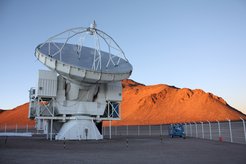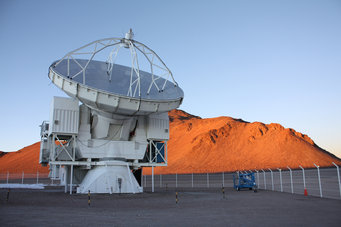Bleach discovered in space
Astronomers find key molecule hydrogen peroxide with the APEX Telescope in Chile
Rho Ophiuchi would have been a gold mine for hairdressers. Astronomers have now detected molecules of hydrogen peroxide for the first time in this stellar nursery 400 light years away. This liquid compound of hydrogen and oxygen is used to bleach hair. The researchers are interested in another aspect, however. How does water, life's most important molecule, form in interstellar space?

Hydrogen peroxide is thought to form in space on the surfaces of cosmic dust grains - very fine particles similar to sand and soot - atomic hydrogen (H) is added to oxygen molecules (O2). A further chemical reaction between the hydrogen peroxide and more hydrogen can lead to the formation of water (H2O).
"We don't yet know how some of the most important molecules here on Earth are formed in space,” says Bérengère Parise, head of the Emmy Noether research group on star formation and astrochemistry at the Max Planck Institute for Radio Astronomy in Bonn, “but our discovery of hydrogen peroxide seems to be showing us that cosmic dust is the missing ingredient we have been looking for.”
To work out how exactly the formation processes of these important molecules can be intertwined will need more observations of Rho Ophiuchi and other star-forming regions with the telescopes of the future such as ALMA (Atacama Large Millimeter Array) which is also currently being built on the Chajnantor plateau - and help from chemists in laboratories on Earth.
******************
The team comprised Per Bergman (Onsala Space Observatory, Chalmers University of Technology, Onsala, Sweden), Bérengère Parise (Max Planck Institute for Radio Astronomy, Bonn, Germany), Robert Liseau (Chalmers University of Technology, Onsala, Sweden), Bengt Larsson (Stockholm University, Sweden), Hans Olofsson (Onsala Space Observatory, Chalmers University of Technology, Onsala, Sweden), Karl M. Menten and Rolf Güsten (both Max Planck Institute for Radio Astronomy, Bonn).
The Atacama Pathfinder Experiment (APEX) is a collaboration between the Max Planck Institute for Radio Astronomy (MPIfR), Onsala Space Observatory (OSO), and the European Southern Observatory (ESO) to construct and operate a modified prototype antenna of ALMA (Atacama Large Millimetre Array) as a single dish on the Chajnantor plateau at an altitude of 5,100 meters above sea level (Atacama Desert, Chile). The telescope was manufactured by VERTEX Antennentechnik in Duisburg, Germany. The operation of the telescope is entrusted to ESO.
The Emmy Noether Programme of the German Research Foundation (DFG) supports young researchers in achieving independence at an early stage of their scientific careers. Young postdocs gain the qualifications required for a university teaching career during a DFG-funded period, usually lasting five years, in which they lead their own independent junior research group.
NJ / HOR
